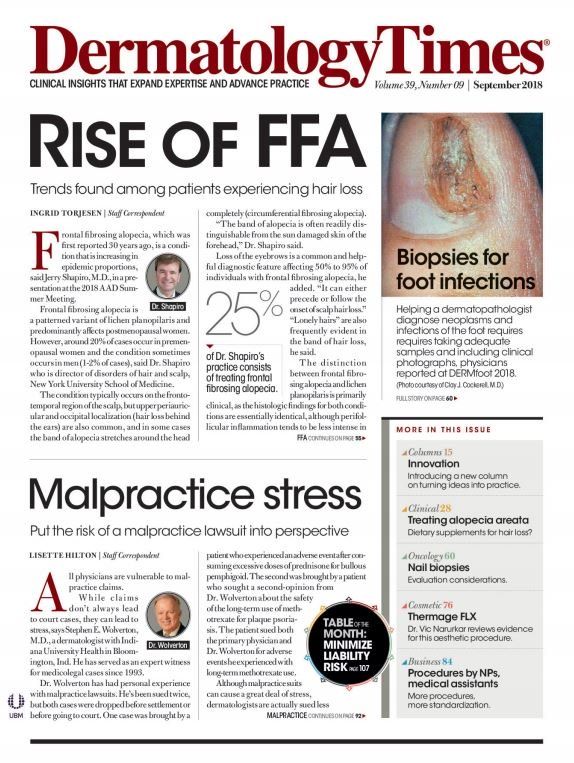- Acne
- Actinic Keratosis
- Aesthetics
- Alopecia
- Atopic Dermatitis
- Buy-and-Bill
- COVID-19
- Case-Based Roundtable
- Chronic Hand Eczema
- Chronic Spontaneous Urticaria
- Drug Watch
- Eczema
- General Dermatology
- Hidradenitis Suppurativa
- Melasma
- NP and PA
- Pediatric Dermatology
- Pigmentary Disorders
- Practice Management
- Precision Medicine and Biologics
- Prurigo Nodularis
- Psoriasis
- Psoriatic Arthritis
- Rare Disease
- Rosacea
- Skin Cancer
- Vitiligo
- Wound Care
Publication
Article
Dermatology Times
Vermilion lip carcinoma five times more sensitive to metastasis
Author(s):
Chance of metastasis for cutaneous squamous cell carcinomas of vermillion lip is five times greater than on the cutaneous lip, study shows.
Cutaneous squamous cell carcinomas (cSCCs) that are located on the vermilion lip are at higher risk of nodal metastasis than those located on the cutaneous lip.
In a cohort study of more than 300 patients with cSCCs of the lip, the risk of nodal metastasis was five times greater for vermilion lip tumors compared with cutaneous lip tumors, investigators at Brigham and Women’s Hospital and Harvard Medical School, Boston, have found. The metastatic potential of vermilion lip tumors has been hypothesized to be greater than cSCCs on the cutaneous lip because of the absence of subcutaneous fat in the vermilion lip, making it more prone to deep invasion.
To test this hypothesis, the researchers identified 303 patients with 310 cSCCs from a query of the Partners HealthCare System Research Patient Data Registry. A total of 138 (44.5%) were located on the cutaneous lip and 172 (55.5%) on the vermilion lip. Some 86% of tumors were less than 2 cm in diameter, 77% were well differentiated, 92% were confined to the dermis, and 93% were free of perineural invasion. Mohs surgery was used as primary treatment in about two thirds (64%).
Tumors on the vermilion lip were more likely to have a larger diameter and more aggressive histologic characteristics than those on the cutaneous lip. On multivariable analysis, the risk of nodal metastaisis for cSCCs on the vermilion lip was 5-fold higher than the risk for cSCCs on the cutaneous lip (7.5% vs. 1.5%), independent of depth of invasion (P=0.04).
The authors wrote that the finding “suggests that the recently updated AJCC [American Joint Committee on Cancer] 8 criteria and BWH [Brigham and Women’s Hospital] cSCC staging may not adequately account for the increased risk inherent to vermilion lip location.” They noted that AJCC 8 eliminated a location-based criterion for cSCC of the head and neck “in part because studies in the existing literature have inconsistently analyzed, failed to analyze, or were underpowered to analyze risk differences between the lip zones in cSCC.”
REFERENCE
David M. Wang, BA; Stefan Kraft, MD; Pooyan Rohani, MD, MEngr; et al. “Association of nodal metastasis and mortality with vermilion vs cutaneous lip location in cutaneous squamous cell carcinoma of the lip,” JAMA Dermatology 2018;154(6):701-7. doi:10.1001/jamadermatol.2018.0792

Newsletter
Like what you’re reading? Subscribe to Dermatology Times for weekly updates on therapies, innovations, and real-world practice tips.























